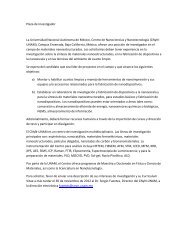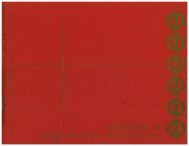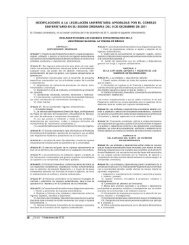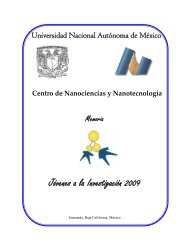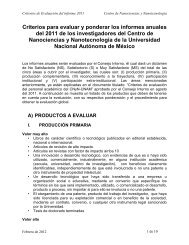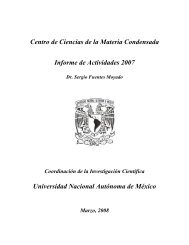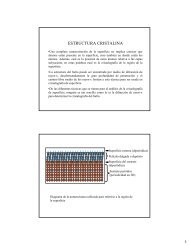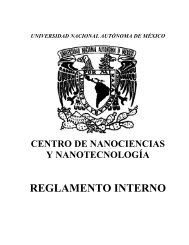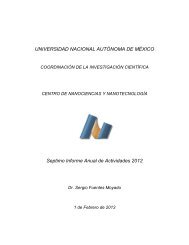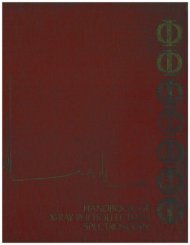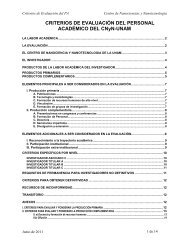Universidad Nacional Autónoma de México - CNyN
Universidad Nacional Autónoma de México - CNyN
Universidad Nacional Autónoma de México - CNyN
Create successful ePaper yourself
Turn your PDF publications into a flip-book with our unique Google optimized e-Paper software.
1st International Symposium on Nanoscience and Nanomaterials<br />
Keywords: Atomic layer <strong>de</strong>position, automation, growth rate.<br />
The ever increasing need to build nanoscale <strong>de</strong>vices has led to the search of alternative techniques to<br />
<strong>de</strong>posit thin films on complex shaped surfaces. The required characteristics of the <strong>de</strong>posited films inclu<strong>de</strong><br />
good conformality, step coverage, excellent uniformity, and high repeatability with precise control at atomic<br />
scale. The atomic layer <strong>de</strong>position (ALD) technique fits those requirements; since the <strong>de</strong>position is carried out<br />
trough surface reactions that are both self-saturated and -limited. ALD is a very powerful technique for<br />
applications like capacitors for integrated circuits, diffusion barriers in transistor and others. In this work we<br />
present the <strong>de</strong>velopment of a fully automated atomic layer <strong>de</strong>position system built at the <strong>CNyN</strong>.<br />
Improvements over other similar systems and automation <strong>de</strong>tails are discussed. For example the reactant<br />
(H 2 O) was relocated out from the main manifold to prevent oxi<strong>de</strong> <strong>de</strong>posits on the walls of the manifold. This<br />
help to maintain a constant pressure for at least 2000+ ALD cycles; compared to 200 ALD cycles when the<br />
water is dosed to the precursor’s manifold. To characterize the system, we prepared Al 2 O 3 and TiO 2 films<br />
from trymethyl aluminum (TMA) and tetrakis (dimethylamino) titanium (TDMAT) chemical precursors,<br />
respectively, on silica substrate. We present the influence of the precursor type on the saturation behavior,<br />
which leads to different growing rates of 1.1 Ǻ /cycle for the Al 2 O 3 and 0.9 Ǻ /cycle for TiO 2 . This work was<br />
financially supported by CONACyT grants #83275 and #82984, and DGAPA IN114209-3. We acknowledge<br />
the technical assistance of A. Tiznado, E. Medina, J. Díaz and P. Pizá.<br />
P-013<br />
ABOUT CONGRUENT SPHERE PACKING IN THE NANOPOROUS STRUCTURES<br />
Larysa Burtseva 1,a , Vitalii Petranovskii 2,b<br />
1 Engineering Institute of the Autonomous University of Baja California, Calle <strong>de</strong> La Normal, S/N, Col.<br />
Insurgentes Este, C.P. 21270, Mexicali, B.C., Mexico<br />
2 <strong>Universidad</strong> <strong>Nacional</strong> Autónoma <strong>de</strong> México, Centro <strong>de</strong> Nanociencias y Nanotecnología, Apdo. Postal 14,<br />
C.P. 22800, Ensenada, B.C., México<br />
a lpb@iing.mxl.uabc.mx, b vitalii@cnyn.unam.mx<br />
Keywords: sphere packing, optimization, packing mo<strong>de</strong>l, <strong>de</strong>nsity function, nanopores,<br />
nanochannel, nanocavity.<br />
In many cases atoms in the structural mo<strong>de</strong>ls appears as a hard congruent spheres. Crystalline<br />
structures of simple metals have so called “<strong>de</strong>nse packed structures”. For example, gold have face centered<br />
cubic structure and in bulk state (that is in infinite volume) has space group Fm3m. While passing from bulk<br />
to nanoparticles, translational symmetry is lost, and new coordination states appears for clusters and<br />
nanoparticles, especially for those supported in nanopores of different supports. In this work the problem of<br />
packing of congruent spheres (atoms) in a cylindrical container (nanochannel) of minimal height is<br />
consi<strong>de</strong>red. While diameter of a channel (D) is less than diameter of sphere (d), no filling happens. Starting<br />
from D ≥ d, in the range of relatively low D/d ratios, the local arrangement of atoms in nanoparticles<br />
stabilized insi<strong>de</strong> of nanochannels start to be sensitive to this ratio, in such a way opening possibility for one<br />
more method of tuning of nanoparticle properties. Zeolites can be not only the “molecular sieves” but clusters<br />
sieves too. This problem belongs to the optimization problems of Computational Geometry and is known to<br />
30




